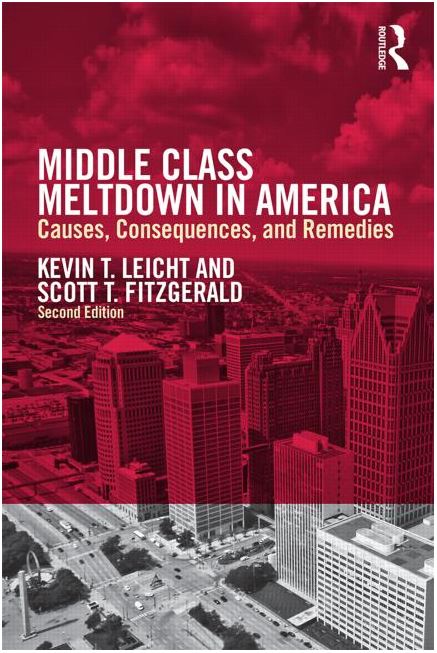The ailing – and failing – American middle class

An economic meltdown threatens America’s middle class. UNC Charlotte sociologist Scott Fitzgerald’s most recent book, Middle Class Meltdown in America: Causes, Consequences and Remedies, co-authored with Kevin T. Leicht, examines the political, economic and cultural changes that have created today’s situation.
Fitzgerald will discuss the issues at 6:30 p.m. Thursday, Sept. 18, in a free community talk at UNC Charlotte Center City. It’s the first of the 2014-15 “Personally Speaking” author series, presented by UNC Charlotte’s College of Liberal Arts & Sciences and Atkins Library.
Fitzgerald, an associate professor of sociology, talked earlier this week with UNC Charlotte Urban Institute associate director Mary Newsom. An edited version of the interview follows:
In Middle Class Meltdown in America you say the middle class is in real trouble. What led to that conclusion?
One of the things that has happened since 2008-2009, or the Great Recession, is an awareness of how difficult things are, even for those who have jobs and education, who are working and doing all the things we were taught to do to be successful.
In the 1950s and 1960s you knew what the rules of the game were: Get a job, and you could anticipate staying there a long time. Raise a family, buy a home, provide opportunities for your children. Your hard work would be rewarded by your employer. There was stability for the American middle class.
long time. Raise a family, buy a home, provide opportunities for your children. Your hard work would be rewarded by your employer. There was stability for the American middle class.
What we see now is a different social reality. Job stability is pretty much nonexistent and wages have flat-lined. But the costs associated with being middle class – housing, health care, child care, higher education – are going up. People struggle financially.
In the past few years there’s been increased public discussion that there’s something wrong here. But to understand the current situation you need to go back before the Great Recession. What we see in 2014 is the result of a process since the 1970s. We’ve seen an increase in productivity across industries. Rising productivity generates higher profits. Productivity increased dramatically, and CEO and elite incomes increased dramatically. But the average workers’ incomes were stagnant across those 40 years.
The middle class continued to do all the things we’ve been taught – buy houses, send our kids to college – and that wasn’t being financed by increased wages but by the availability of credit. That allowed the middle class to continue to provide the engine for our economy – consumer spending – but they were racking up consumer debt.
Part of the story, politically, is the deregulation of key industries that began in the 1980s. The deregulation of the financial industry profoundly reshaped and altered the experience of the middle class. It became profitable for financial firms to extend more and more credit. They were getting more and more people into homes they couldn’t otherwise afford. We were creating this economic house of cards which was almost inevitably going to come down.
Your book compares the U.S. middle class today with peasants in the Middle Ages and sharecroppers in the 19th century. Can you elaborate?
In the study of political economy, to understand societies you need to look at the economic arrangements. They tell us a lot about power and control in the society in general.
Feudal societies involved landowners, and serfs who worked the land. If you were an indentured servant or serf, you were beholden to a landowner. You would work the land, and the majority of the profits of what you did went to the landowner. You had a sort of subsistence-level survival but little political or economic freedom.
There are some striking parallels between the middle class today and those serfs or peasants in earlier societies, because of the debt the middle class has taken on, to maintain the lifestyle and to drive this consumer-based economy we have. The American middle class is indentured – but not to particular people. They’re indebted to a system. It’s an economic system that involves borrowing money to sustain current spending, but then being so in debt you have to work longer and longer hours just to survive.
You point to what you call “the marketing of an illusion” – the idea that the free market is the best solution to the problem. Some people might say you sound like a socialist.
I think the ideas in the book and the critique of the economic system can be very difficult for some other people to hear. But first, I want to emphasize that market economies have many strengths. Market economies are responsible for the American middle class we have – for the economic opportunities that to this day are something people from around the world flock to and want to emulate.
to this day are something people from around the world flock to and want to emulate.
Markets do many things well. However, they are not perfect. We need to recognize what markets do well and what they don’t do well. Rather than asking whether we should have markets, what we’re asking is how the rewards of market activity should be distributed.
That might sound to some people like “wealth redistribution.”
I think a key question in thinking about how we distribute the rewards of economic systems is not fundamentally this notion of “wealth redistribution.” That immediately conjures ideas of after-the-fact distributions, that something would be appropriated by one entity and given to another. Rather we should ask more fundamental questions about the structure of wages and the rewards for business – questions about what we value as a society.
When we look at trends of productivity and profits over a 40-year period we see a clear upward trajectory. When we look at wages of workers, we see a flat line. So the more important question is where those rewards should go. Should they be reinvested in the very people whose spending sustains our economy?
There’s a persistent belief among many that cutting taxes leads to wider prosperity – so-called trickle-down economics. Thoughts?
The idea of trickle-down economics gained a lot of traction in the 1980s. The idea was really championed by Ronald Reagan, though there’s plenty of blame across the political parties. The idea gained traction quickly and for quite some time, even though the empirical evidence was dubious at best, and never really played out that way.
It’s part of a political ideology, the idea that fiscal austerity and limited government would generate economic returns that would be better than the alternatives. Even though in the past 40 years we did not see the rising tide lifting all boats, there are still many champions of the idea that to boost the economy we need to remove regulations and taxes that affect the generation of wealth.
What accounts for the persistence of that belief?
One reason this ideology has persisted is that it’s an ideology. Ideologies shape and filter what we see. They do not disappear when contradictory evidence appears. For many who believe trickle-down economics works, it’s not based on evidence or on what has actually happened over 40 years, it’s because they believe that it works.
Also, the idea of trickle-down economics taps into a notion of the American Dream which has been around for centuries: If you work hard, if you’re careful, if you have a good work ethic, you can succeed. It’s a powerful cultural idea. When people are successful, they tend to attribute it to their own actions. The flip of that is when people are not successful the assumption is there must be some short-coming, or they did something that caused that to happen.
It’s a sort of gloomy book. Are there any rays of hope?
One thing we can learn from our research is to understand how we could respond to the issue, both as individuals and collectively. The first step is identifying and understanding the problem.
As individuals, we can continue to pursue higher education. It still provides the best avenue for upward mobility. It’s not a guarantee, but it is one of your best bets. Choosing how we use debt is important – making distinctions between good debt and bad debt, and limiting expenditures.
But regardless of what we do as individuals, we need to recognize that in the end these are not individual problems, they are collective, societal-level problems.
We should continue to find ways to support what the American Dream really is. Some of those supports include affordable health care, pensions and affordable higher education.
And I think we also need to find ways to reward companies that reward worker loyalty, and to reward companies for generating jobs rather than moving offshore or cutting jobs.